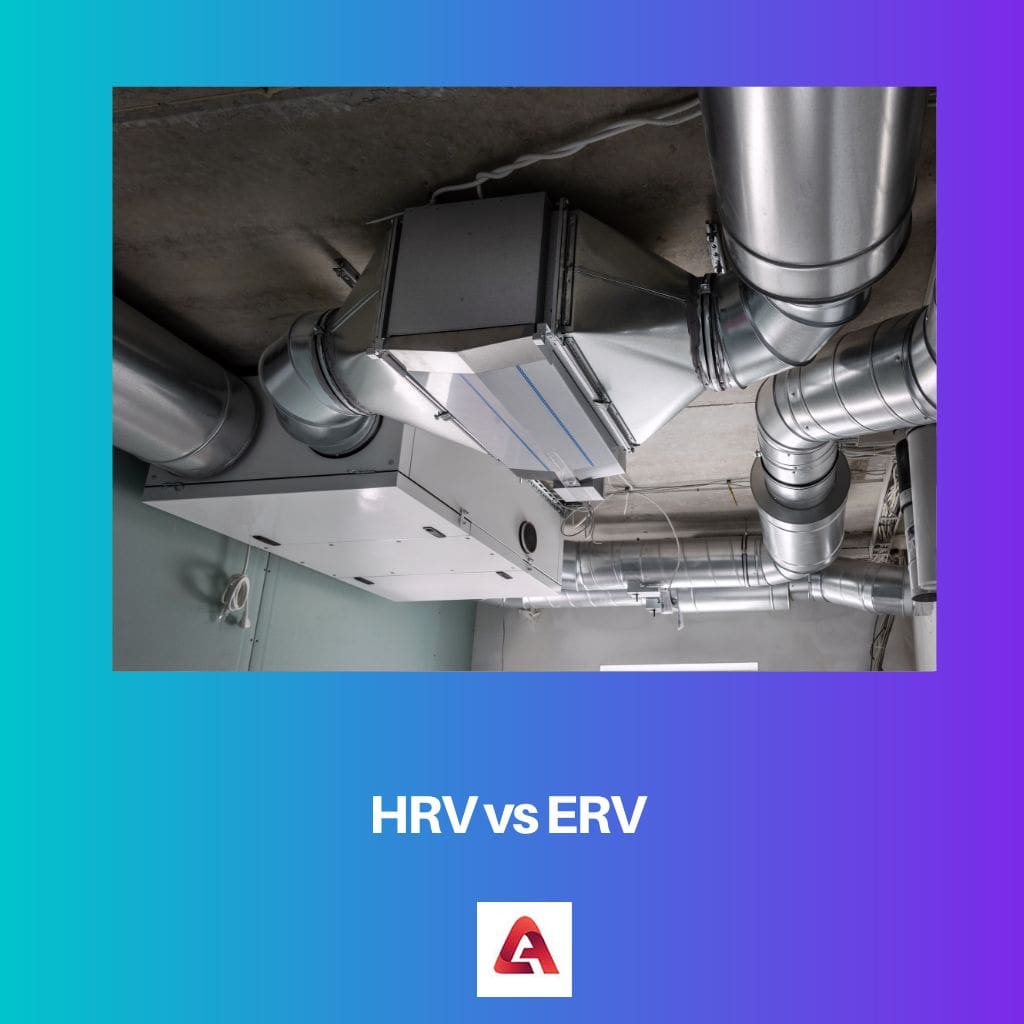With the increasing pollution, the importance of ventilation has increased tremendously. So, the introduction of various types of ventilation has manifested to be helpful in these times, but also, with so many categories, one can easily get confused between them.
One such topic of discussion is the HRV and ERV. Both are types of ventilations that appear to be strikingly similar but are fundamentally different.
Key Takeaways
- HRV (Heat Recovery Ventilation) is a type of ventilation system that helps maintain indoor air quality by recovering heat from exhaust air. At the same time, ERV (Energy Recovery Ventilation) is a type of ventilation system that recovers heat and moisture from exhaust air.
- HRV is more suitable for colder climates, where indoor heating is required for a longer duration, while ERV is more suitable for hot and humid climates, where air conditioning is used more often.
- ERV systems are more expensive than HRV systems but can help reduce overall energy costs.
HRV vs ERV
HRV systems use heat exchangers to transfer heat from exhaust air to incoming fresh air, reducing energy loss and reducing humidity levels. ERV systems transfer moisture between the incoming and outgoing air streams, improving indoor air quality and reducing the risk of mold growth.

HRV or Heat Recovery Ventilation, is a type of ventilation that operates between two temperature sources. It reduces the heating and cooling demands of the house, thereby enhancing the air quality index.
It operates with less energy loss but is slightly more expensive than other ventilation systems.
On the other hand, ERV or Energy Recovery Ventilation, is a system that uses both heat and moisture in the stale exhaust air to purify. Thus, an ERV system ensures that the indoor air does not become too dry during winter by retaining moisture and humidity.
Comparison Table
| Parameters of Comparison | HRV | ERV |
|---|---|---|
| Stands For | Heat Recovery Ventilation/Ventilator | Energy Recovery Ventilation/ Ventilator |
| Retains | Heated/ Cooled Air | Heat, Moisture, Relative Humidity |
| Suitable For | Humid Houses in Winters | Dry Houses in Winters |
| Efficiency | About 55-75% | Approx. 70% |
| Perks | Saves Heating Bills | Reduces load on Dehumidifier |
What is HRV?
As aforementioned, the HRV or Heat Recovery Ventilation System (also called MVHR-Mechanical Ventilation Heat Recovery) is one of the systems used to enhance indoor air quality by retaining and purifying the heat from the stale exhaust air.
It primarily uses this heat to preheat the air entering the house. It is compared heavily to the human breathing system.
The HRV Ventilator Core is considered to be the lungs of the system. It is the only place where the exchange of air primarily takes place.
Although this process occurs in a single area, the incoming and outgoing air never mixes as they pass through separate tunnels. Exchange occurs through the principle of conduction.
An HRV requires a fan to operate 24/7 and still saves and recovers most energy costs. This recovered energy determines the ‘Efficiency Rate’. It is different for different brands of HRV but varies between 55 to 75%.
Some HRVs can go up to 93% efficiency, depending on the quality of the fan. Although these high-efficiency HRVs are slightly over-priced, other HRVs provide amazing service and quality.
The only disadvantage of an HRV is the quality of the fan that needs to operate continuously. Most of the low-priced HRVs carry low-quality fans that can be damaged easily.
But with increasing demand, almost all the companies are ready to give a full-time warranty and replacement guarantee.
Usually, high-efficiency HRVs are found and extensively used in Canada, The United States, and Europe, but with each passing year, HRVs are increasing tremendously.
What is ERV?
As mentioned above, ERV or Energy Recovery Ventilation System focuses on enhancing the indoor air quality index by retaining heat and humidity from the stale exhaust air, thus minimizing energy loss and reducing the load on air conditioners and dehumidifiers.
ERV captures the moisture to increase the dried-out room’s humidity in winter lightly. It maintains the room’s humidity in winter from 40-60%.
In summer, an ERV precools and humidifies the air in the room, whereas in winter, it preheats and humidifies the room.
ERVs have a lower energy requirement than other ventilation systems as they use a blower which requires certain power. ERV is called ‘Total Enthalpic Devices’ as they transfer latent and sensible heat.
ERVs work reversely in the summers by removing the humidity outside the room before injecting it into the house, thus saving the energy load on air conditioners.
ERVs have great efficiency of at least 70%, but studies and research are going on to at least increase the efficiency up to 90%. ERV is perfect for houses that get too hot and dry in winter.
Apart from slight energy requirements, ERVs have practically no huge disadvantage. They have manifested to be useful in improving air quality and reducing global warming drastically.
Main Differences Between HRV and ERV
- HRV or Heat Recovery Ventilation System uses the transfer of heat only. On the other hand, ERV or Energy Recovery Ventilation System uses the transfer of both heat and humidity/ moisture.
- HRVs can only transfer sensible heat. In contrast, ERVs can transfer both sensible heat and latent heat.
- HRVs are called Sensible Only Devices, whereas ERVs are referred to as Total Enthalpic Devices.
- HRVs are used for newly built airtight homes with good reasonable humidity. On the other hand, ERVs are perfect for older homes with less humidity and drier rooms.
- HRVs have an efficiency of 55-75%, with maximum efficiency of up to 93%. In contrast, ERVs have an efficiency of up to 70%.



